Ryan Dull, Tim Mayza, and Spencer Turnbull on Learning Their Sliders
Pitchers learn and develop different pitches, and they do so at varying stages of their lives. It might be a curveball in high school, a cutter in college, or a changeup in A-ball. Sometimes the addition or refinement is a natural progression — graduating from Pitching 101 to advanced course work — and often it’s a matter of necessity. In order to get hitters out as the quality of competition improves, a pitcher needs to optimize his repertoire.
In this installment of the series, we’ll hear from three pitchers — Ryan Dull, Tim Mayza, and Spencer Turnbull — on how they learned and developed their sliders.
———
Ryan Dull, Oakland A’s
“I started messing around with a slider my junior year of college. We happened to have some scouts over — it was a scout-day — and they talked to my coach about my curveball. They said I would best benefit by getting rid of it altogether, and throwing a slider. The day after that, I got together with the guy on our team who had the best slider, and started working on one. We worked on it every day.
“I actually started throwing it with a softball at first. My pitching coach in college, Aaron Rembert, had me do that. It helps give you a feel of how you get on top, and around, it. It won’t move like it would if it were a baseball, but you’ll be able to see the spin. You throw five to ten [pitches] with a softball, then take a baseball, which will give you the break you want. Read the rest of this entry »


